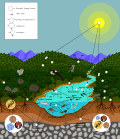Lotka–Volterra equations, also known as the Lotka–Volterra predator–prey model, are a pair of first-order nonlinear[disambiguation needed] differential equations, frequently...
32 KB (4,237 words) - 14:38, 22 April 2024
Predation (redirect from Predator and prey)
a biological interaction where one organism, the predator, kills and eats another organism, its prey. It is one of a family of common feeding behaviours...
109 KB (11,476 words) - 05:46, 16 May 2024
of the environment. The classic predator–prey equations are a pair of first order, non-linear, differential equations used to describe the dynamics of...
34 KB (4,251 words) - 16:41, 26 April 2024
Predator–prey reversal is a biological interaction where an organism that is typically prey in the predation interaction instead acts as the predator...
18 KB (2,268 words) - 19:01, 27 January 2024
for example, wolves prey mostly upon large herbivores (primary consumers), which eat plants (primary producers). The apex predator concept is applied in...
33 KB (3,259 words) - 00:15, 24 April 2024
equation Hypergeometric differential equation Jimbo–Miwa–Ueno isomonodromy equations Painlevé equations Picard–Fuchs equation to describe the periods of elliptic...
13 KB (1,105 words) - 18:40, 13 December 2023
cyclically around a fixed point, such as the one delineated by the predator-prey equations, would be described as persistent and resilient, but not as constant...
22 KB (2,734 words) - 01:29, 28 April 2024
Prey switching is frequency-dependent predation, where the predator preferentially consumes the most common type of prey. The phenomenon has also been...
9 KB (1,321 words) - 19:45, 4 January 2024
Arditi–Ginzburg equations describe ratio-dependent predator–prey dynamics. Where N is the population of a prey species and P that of a predator, the population...
5 KB (570 words) - 10:10, 25 April 2024
(1860–1940), Italian mathematician Lotka–Volterra equations, also known as the predator–prey equations Smith–Volterra–Cantor set, a Cantor set with measure...
1 KB (174 words) - 20:48, 3 May 2024
became known as the Malthusian growth model. The Lotka–Volterra predator-prey equations are another famous example. Population dynamics overlap with another...
41 KB (4,307 words) - 17:02, 14 April 2024
For this reason, functional differential equations are more applicable than ordinary differential equations (ODE), in which future behavior only implicitly...
14 KB (2,179 words) - 03:34, 2 February 2024
generalized Lotka–Volterra equations are a set of equations which are more general than either the competitive or predator–prey examples of Lotka–Volterra...
12 KB (1,817 words) - 02:00, 21 March 2024
formulation. The Lotka–Volterra predator-prey equations are another famous example, as well as the alternative Arditi–Ginzburg equations. Simplified population...
26 KB (2,850 words) - 02:02, 21 March 2024
predicted by the Lotka-Volterra equation, with the peaks in prey abundance shifted slightly to the left of the peaks of the predator densities. Huffaker's experiments...
14 KB (1,735 words) - 05:19, 27 December 2023
differential equations within biology is Lotka-Volterra equations are prey-predator equations A governing equation may also be a state equation, an equation describing...
8 KB (897 words) - 00:14, 10 October 2023
It is a specialist predator and depends heavily on the snowshoe hare (Lepus americanus) for food. This leads to a prey-predator cycle, as the Canada...
70 KB (7,985 words) - 01:08, 2 May 2024
Carnivore (redirect from Beast of prey)
terrestrial vertebrate to develop the curved, serrated teeth that enable a predator to eat prey much larger than itself." While amphibians continued to feed on fish...
17 KB (1,652 words) - 17:03, 14 May 2024
formulation. The Lotka–Volterra predator-prey equations are another famous example, as well as the alternative Arditi–Ginzburg equations. When describing growth...
31 KB (3,551 words) - 13:42, 29 April 2024
Ecology of fear (redirect from Predator-induced stress)
the animals already living in the environment. Predator-prey dynamics – Equations modelling predator–prey cyclesPages displaying short descriptions of redirect...
12 KB (1,416 words) - 18:05, 31 December 2023
Keystone species (redirect from Keystone predator)
is a predator that prevents a particular herbivorous species from eliminating dominant plant species. If prey numbers are low, keystone predators can be...
29 KB (3,186 words) - 00:23, 15 May 2024
Intraguild predation (redirect from Intraguild predator)
other, or symmetrical, in which both species prey upon each other. Because the dominant intraguild predator gains the dual benefits of feeding and eliminating...
16 KB (1,726 words) - 02:17, 17 March 2024
Herbivore (redirect from Plant predator)
equation models the efficiency at which predators consume prey. The model predicts that as the number of prey increases, the amount of time predators...
53 KB (6,209 words) - 17:22, 10 April 2024
set of first-order, nonlinear, differential equations, which are frequently used to describe predator–prey interactions, can be modified to account for...
8 KB (1,138 words) - 16:58, 4 March 2023
experiments in which prey densities are artificially manipulated, but is rare in nature. Ecosystem model Lotka–Volterra equations Predator satiation Holling...
9 KB (1,211 words) - 20:30, 5 May 2024
between modelled and real predator–prey interactions. Rosenzweig used ordinary differential equation models to describe changes in prey populations. Enrichment...
10 KB (1,524 words) - 20:34, 6 February 2024
Theoretical ecology (section Predator–prey interaction)
populations of both predator and the prey. In 1925, the American mathematician Alfred J. Lotka developed simple equations for predator–prey interactions in...
62 KB (7,491 words) - 00:10, 7 April 2024
experiments with predatory and herbivorous mite species to investigate predator–prey population dynamics. In these experiments, he created model universes...
15 KB (2,145 words) - 11:22, 23 March 2024
Shoaling and schooling (redirect from Predator avoidance in schooling fish)
become circular. Forage fish are small fish which are preyed on by larger predators for food. Predators include other larger fish, seabirds and marine mammals...
104 KB (12,070 words) - 15:03, 22 March 2024
Clements, was important in early plant ecology. Alfred Lotka's predator-prey equations, G. Evelyn Hutchinson's studies of the biogeography and biogeochemical...
82 KB (10,083 words) - 07:07, 13 May 2024
















